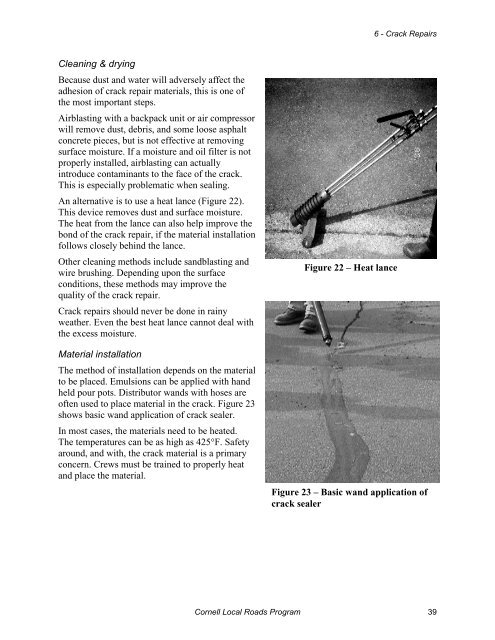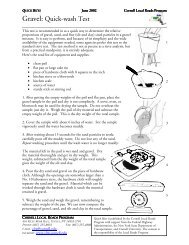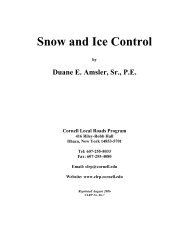Pavement Maintenance - Cornell Local Roads Program - Cornell ...
Pavement Maintenance - Cornell Local Roads Program - Cornell ...
Pavement Maintenance - Cornell Local Roads Program - Cornell ...
You also want an ePaper? Increase the reach of your titles
YUMPU automatically turns print PDFs into web optimized ePapers that Google loves.
Cleaning & drying<br />
Because dust and water will adversely affect the<br />
adhesion of crack repair materials, this is one of<br />
the most important steps.<br />
Airblasting with a backpack unit or air compressor<br />
will remove dust, debris, and some loose asphalt<br />
concrete pieces, but is not effective at removing<br />
surface moisture. If a moisture and oil filter is not<br />
properly installed, airblasting can actually<br />
introduce contaminants to the face of the crack.<br />
This is especially problematic when sealing.<br />
An alternative is to use a heat lance (Figure 22).<br />
This device removes dust and surface moisture.<br />
The heat from the lance can also help improve the<br />
bond of the crack repair, if the material installation<br />
follows closely behind the lance.<br />
Other cleaning methods include sandblasting and<br />
wire brushing. Depending upon the surface<br />
conditions, these methods may improve the<br />
quality of the crack repair.<br />
Crack repairs should never be done in rainy<br />
weather. Even the best heat lance cannot deal with<br />
the excess moisture.<br />
Material installation<br />
The method of installation depends on the material<br />
to be placed. Emulsions can be applied with hand<br />
held pour pots. Distributor wands with hoses are<br />
often used to place material in the crack. Figure 23<br />
shows basic wand application of crack sealer.<br />
In most cases, the materials need to be heated.<br />
The temperatures can be as high as 425°F. Safety<br />
around, and with, the crack material is a primary<br />
concern. Crews must be trained to properly heat<br />
and place the material.<br />
Figure 22 – Heat lance<br />
6 - Crack Repairs<br />
Figure 23 – Basic wand application of<br />
crack sealer<br />
<strong>Cornell</strong> <strong>Local</strong> <strong>Roads</strong> <strong>Program</strong> 39





